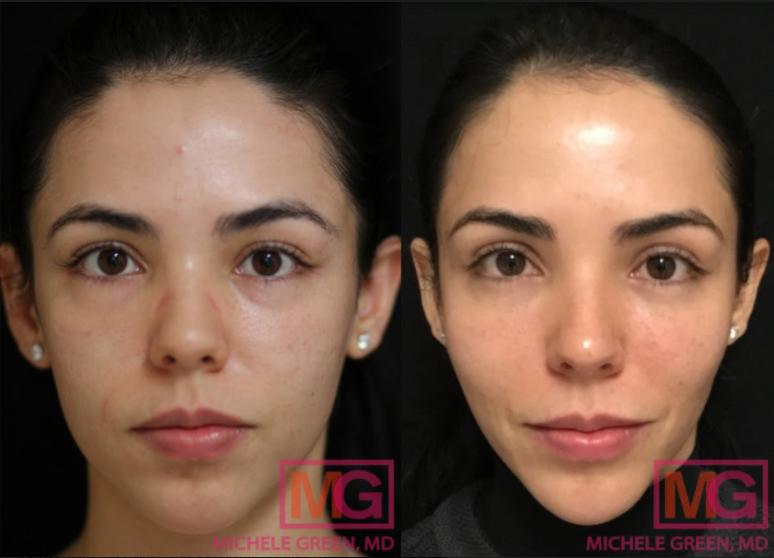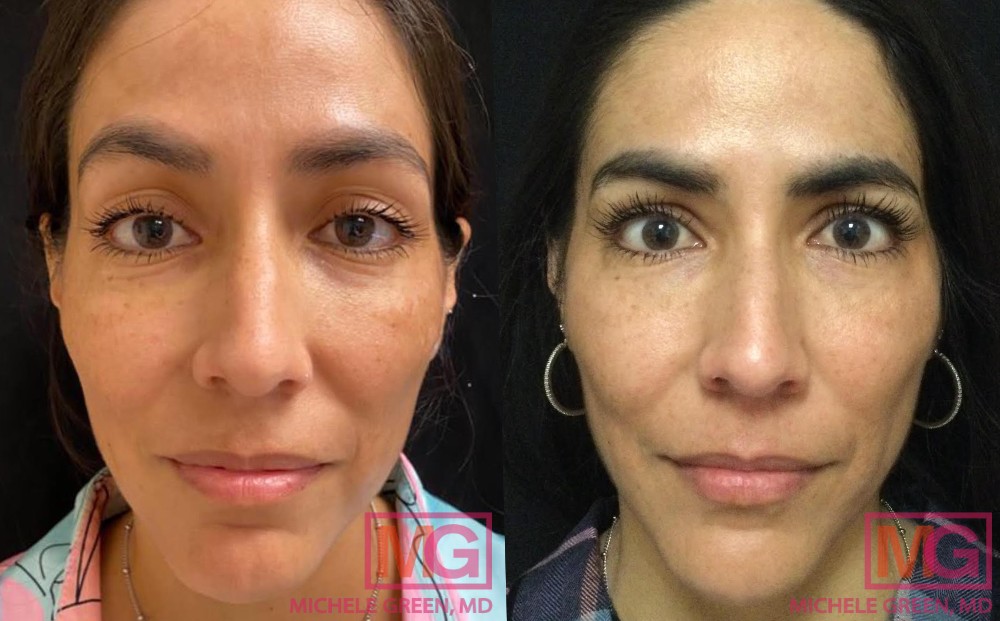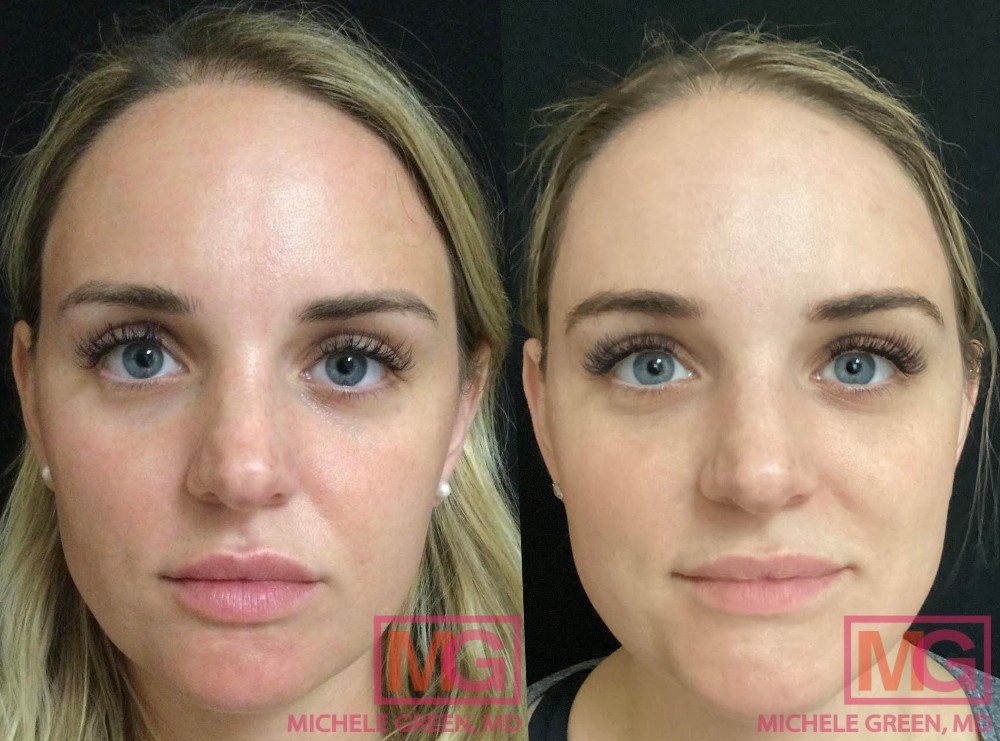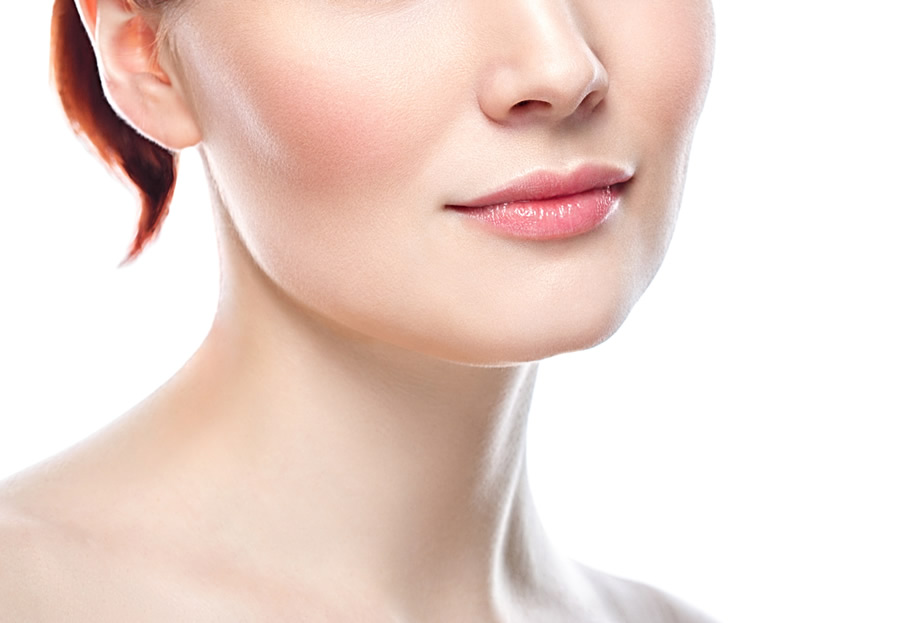Bruising After Cheek Fillers
Cheek filler and dermal filler treatments have risen in popularity in the world of cosmetic dermatology. As we age, the rate of collagen production slows and existing collagen in the skin breaks down, leading to volume loss, fine lines, wrinkles, and skin sagging that cause you to look older. Collagen is an essential component in the skin that acts as structural support and provides the foundation for a supple, smooth, and youthful complexion. Cheek fillers are the perfect non-invasive treatment to fight signs of aging by restoring lost volume and giving your facial structure a lift, softening the appearance of wrinkles and skin laxity. Expert injectors like Dr. Michele Green in New York City are able to reverse the aging process and contour the face through non-invasive treatments like cheek fillers. Dr. Green utilizes various dermal fillers, including the popular hyaluronic acid fillers like Juvederm and Restylane, as well as Sculptra Aesthetics to create facial rejuvenation and natural-looking youthfulness.
Many patients from all over the world come to Dr. Green for her light touch and expertise in cosmetic procedures that produce the most natural-looking, youthful complexion. Dr. Michele Green is a board-certified dermatologist with over 25 years of experience in anti-aging, facial rejuvenation, and injections with Botox, Restylane, Juvederm, Sculptra, and Belotero. Patients often have important events like weddings and professional shows that they want to look their best for, which means there is limited time for bruising and swelling after injections. With your busy schedule in mind, Dr. Green will carefully address your aesthetic goals and conduct a thorough assessment to create a customized treatment plan to achieve the best results for your special event.
Dermal Fillers for Cheek Augmentation
Dermal fillers are one of the most popular cosmetic treatments in the U.S. for anti-aging and adding volume to contour the face. Celebrities like Kylie Jenner are a testament to how dermal fillers can contour your facial structure, diminish the appearance of wrinkles, and immediately improve your overall appearance. Additionally, dermal fillers are non-invasive, fast, and effective with minimal downtime. The versatility of dermal fillers is attractive to those looking to treat multiple areas of the face for contouring, such as the chin, jawline, temples, cheeks, and lip fillers. When it comes to non-surgical cheek augmentation, dermal filler injections are the ideal approach. Dermal fillers are semi-permanent, adaptable, and produce immediate results with minimal side effects.
Cheek augmentation is performed to reverse the volume loss that naturally occurs as a result of aging. For some patients, cheek augmentation can be done to re-contour the face for more pronounced cheekbones. Additionally, by adding natural-looking volume to the cheeks, this lift can help soften the appearance of nasolabial or smile lines as well. Dr. Michele Green has been performing dermal filler injections for cheek augmentation for over 25 years in her discreet Upper East Side private dermatology office. She utilizes various types of fillers from Restylane and Juvederm to Sculptra to restore lost volume and contour the facial structure to create a natural-looking, rejuvenated complexion.
Do cheek fillers bruise?
Bruising is the most common side effect associated with any dermal filler injections, which is a normal bodily response to any injections whether medical or cosmetic. Although bruising is more common when dermal fillers are injected in more vascular areas like tear troughs and lips, it can still happen with cheek fillers. Bruising occurs when small blood vessels are punctured with the needle used to inject the filler underneath the skin. Because the cheeks are not as vascular as tear troughs and lips, there is a chance that you may not bruise at all after cheek filler injections. Furthermore, patients who receive a large volume of fillers may experience more bruising than those who receive less volume.

What causes bruising after cheek fillers?
Bruising from cheek fillers is the result of the blood vessels being punctured by the needle used to inject the filler under the skin of the cheeks. When the blood vessel is punctured, its contents, the blood, spills out into the surrounding soft tissue beneath the skin. Bruising is expected with any type of injection, whether medical (i.e., blood tests) or cosmetic (i.e., dermal fillers).
How can you prevent bruising from cheek filler?
There are certain medications you should avoid for one to two weeks prior to your cheek filler appointment. These medications are blood thinning agents that make it more difficult for the blood to clot, increasing the chances of bruising following the injections. If you take any of these medications regularly, make sure you ask the prescribing physician if it is okay to stop these medications.
Medications to avoid include:
- Blood thinners or anticoagulants – These medications prevent your blood from clotting.
- Warfarin, Coumadin, Eliquis, Xarelto, Lovenox, Pradaxa, Heparin
- Antiplatelets – These medications are a type of blood thinners that specifically target platelets in the blood responsible for preventing and stopping bleeding.
- Plavix, Effient, Brilinta
- Aspirin
- NSAIDs (Non-Steroidal Anti-Inflammatory Drugs)
- Motrin, Aleve, Advil, ibuprofen, naproxen
- Excedrin
Tylenol, or acetaminophen, is okay to take for pain before and after filler injections. Tylenol is considered a non-aspirin pain reliever and is not an NSAID, blood thinner, or an antiplatelet.
Some vitamins and supplements should also be avoided for one to two weeks prior to dermal fillers as they have blood-thinning properties that can increase the risk of bruising.
Vitamins and supplements to avoid include:
- Fish oil
- St. John’s Wort
- Vitamin E
- Ginkgo
- Ginseng
- Fenugreek
- Garlic
- Other oils high in omega-3 fatty acids (i.e., flaxseed oil)
Avoid alcohol or green teas for two days before and after the injections. Alcohol and green tea act as vasodilators, which causes blood vessels to relax and open. This leads to an increased risk of bruising after injections like Botox and dermal fillers.
Arnica montana, also known as Arnica, is a flowering plant that naturally grows in sunny environments at higher elevations. Arnica has been utilized for centuries to treat a variety of conditions, including bruising and swelling. Taking Arnica four to five days before and after the cheek filler treatment can help prevent bruising and expedite the healing process if bruising occurs during injections. Arnica comes in capsule and topical form, and both can be used to prevent bruises from forming. Arnica can be found at popular drugstores as an over-the-counter supplement.
Eating fresh pineapple before and after the cheek filler injections can decrease the duration and severity of bruising. Pineapple contains an enzyme called Bromelain found in the juice and stem of the fruit. Bromelain has anti-inflammatory properties that help reduce bruising and swelling.
Ice packs can be applied to the injection sites prior to the filler treatment in order to stimulate vasoconstriction of the blood vessels present and also act as an anesthetic. The cold temperature will shrink the blood vessels, making it less likely that it will be punctured during the injections.

How can you avoid bruising after cheek fillers?
Bruising is a common and temporary side effect from any injections, like cheek fillers. However, you may be worried that the bruising will not heal in time for the big event you have. Thankfully, there are steps you can take to either prevent bruising or help existing bruises heal faster.
Immediately after the cheek filler injections, Dr. Green will apply cold packs, ice packs, or cold compress to the treated areas which will constrict the blood vessels (vasoconstriction) and slow the flow of blood to the injection sites to reduce the risk of bruising. Cold packs help prevent swelling as well. In order to prevent bruising, avoid consuming alcohol for at least 24 hours after the treatment as alcohol acts as a vasodilator and promotes blood flow. It is best to avoid heavy exercise for 48 hours after the injections. Increased heart rate and blood flow from rigorous exercise can contribute to the formation of bruises. By keeping blood flow to a minimum, the damaged blood vessels and capillaries in the treatment area are able to recover faster. If you started taking Arnica four to five days before the cheek filler injections, continue taking it for an additional five days post-treatment.
If you need the bruising to resolve quickly after cheek filler injections, Dr. Green may recommend the VBeam laser. VBeam uses pulsed dye laser technology to specifically target and deliver laser light energy to the blood vessels in the dermis. VBeam can accelerate the healing process to eliminate the bruising quicker. With VBeam treatments, the bruising usually resolves within 24 to 48 hours.
Can you bruise from cheek fillers?
Yes, there is always a possibility that you can bruise from cheek filler injections, as you may with any other injections like vaccinations and blood tests. Bruising occurs when a blood vessel is punctured and the blood spills into the surrounding soft tissue underneath the skin. This is referred to as a hematoma.
If you are worried about potential bruising and swelling after your cheek filler injections and are hesitant to proceed with dermal fillers due to an important event, do not worry. There are precautions you can take to prevent and minimize the bruising, such as avoiding blood-thinning agents like aspirin and fish oil for 2 weeks prior to injections, taking Arnica 2 days before and after the injections, eating fresh pineapple, and applying ice packs after the injections. Expert injector Dr. Michele Green typically advises that you undergo injection treatments one month prior to any important events. This leaves plenty of time for the bruising and swelling to subside, and come for a follow up visit to see if any touch-ups are necessary.
The VBeam Perfecta laser is a great option to accelerate the healing process and help the bruising resolve quicker. The VBeam laser utilizes pulsed dye laser technology to specifically target the chromophores in blood and blood vessels, dispersing them and therefore making the bruise go away faster. Following the VBeam treatment, the bruising will subside within 24 to 48 hours.

How long does swelling and bruising last after cheek filler?
The duration of bruising and swelling varies for each individual. Some people are naturally more prone to bruising than others, such as if you are taking blood thinners. Typically, swelling is most apparent up to 72 hours post-treatment and gradually subsides within a few days. Very rarely, swelling can last from 1-4 weeks. Bruising typically lasts 5-7 days after cheek filler injections, although it can be expedited by using ice packs, Arnica, and avoiding blood thinners and heavy exercise. After VBeam laser treatment, the bruising will subside within 24 to 48 hours. On their own, bruising and swelling will resolve in 1-2 weeks post-treatment.
If you are in a hurry to eliminate bruising after cheek fillers, the VBeam pulsed dye laser is the perfect option for you. VBeam laser works via selective thermolysis. The laser emits a high-intensity light energy at a single wavelength in which the energy is absorbed by the chromophores in the skin. In VBeam, the main chromophore targeted is the hemoglobin in blood or blood vessels. This causes the pigments to disperse and resolve quicker. Dr. Green utilizes the VBeam Perfecta, the latest generation of VBeam laser to accelerate the healing process of the bruises after filler treatments if you need to resolve it quickly for an important event.
How do you hide bruises from fillers?
If you experience bruising from dermal fillers, it is easy to cover up using makeup. There are color-correcting concealer palettes available that utilizes color theory to cancel out the black and blue hue of the bruise. If the bruise is red, use a green concealer as green is opposite of red on the color wheel. If the bruise is blue, use a yellow concealer. If the bruise is yellow, use a lavender concealer. After color correction, apply foundation and concealer that matches your skin tone as needed. Don’t forget to set your makeup with a powder for long-lasting effects.

Is it normal to bruise after cheek filler?
Yes, it is completely normal (and expected) to bruise after cheek filler injections. Bruising occurs when the needle punctures a blood vessel underneath the skin, allowing the blood to pool in the surrounding soft tissue beneath the skin. It is an extremely common and temporary side effect of dermal fillers with an average of 67% of patients reporting bruising.
Some physicians utilize blunt cannulas for dermal fillers to minimize bruising and the risk of passing through a blood vessel. Blunt-tipped needles, also called microcannulas, are small metal cylinders with a side port used instead of needles. A benefit of a microcannula is that there is only one point of entry, reducing the number of injection points. Cannulas are typically about one inch in length that allows for a larger area to be treated. Whether a hypodermic needle or a microcannula is used is up to the injector’s discretion.
Bruising under eye after cheek filler
Sometimes, bruising after cheek filler injections can present in the undereye area. Bruising occurs when the needle punctures an underlying blood vessel and the blood pools in the surrounding soft tissues. The blood can travel to distant sites under the skin, such as under the eyes. Bruising is more visible where the skin is the thinnest, so it is not uncommon to see bruising in the lower lid region after cheek fillers. As with other bruising, bruising under the eyes usually last about one week. Preventing and accelerating the healing process of bruises under eyes are similar to bruising on the cheeks after cheek fillers, such as avoiding blood thinners, taking or applying Arnica, and applying ice packs immediately after the injection treatment.
Will I bruise after cheek fillers?
It is difficult to predict whether an individual will bruise after cheek fillers, as bruising is the most common temporary side effect of dermal fillers. Furthermore, some people are naturally more prone to bruising than others. For example, some patients have thinner and more sun damaged skin, making the appearance of bruises more prominent. The chances of bruising after cheek fillers increase if you are taking blood thinning agents like aspirin, ibuprofen, fish oil, and vitamin E. You will less likely experience bruising after cheek fillers if you avoid taking blood thinners, take Arnica 4-5 days prior to injection treatment, and apply ice packs before and after the treatment to stimulate vasoconstriction.
How can I get started with cheek fillers today?
It can be cumbersome to find an experienced, board-certified dermatologist to perform cosmetic injections that will achieve your aesthetic goals in time for your big event. Dr. Michele Green in New York City offers an array of facial filler options like Juvederm, Restylane, Belotero and Sculptra to guarantee an individualized treatment plan that works best for them. With over 25 years of experience, Dr. Green can reverse signs of aging and create facial contouring with non-invasive cosmetic treatments and minimal downtime. She will carefully listen to your concerns, note the important dates in which you have to look your best for (like your wedding), and create a customized plan to achieve ultimate skin rejuvenation.
Dr. Green is internationally recognized for her artful results and her “less is more” philosophy in cosmetic injections. She is consistently voted one of New York City’s best doctors by Castle Connolly, Super Doctors, New York Magazine, and New York Times. If you are considering cheek filler treatment, want to learn more about cosmetic injections, and how you can achieve natural-looking and youthful complexion, Dr. Green is here to help. As an expert in cosmetic injectables, laser treatments, chemical peels, and skincare, Dr. Green can help you look and feel your best for the big engagement. Please call us today at 212 535 3088 or contact us online to learn more about cheek fillers for anti-aging and skin rejuvenation.
 212-535-3088
212-535-3088